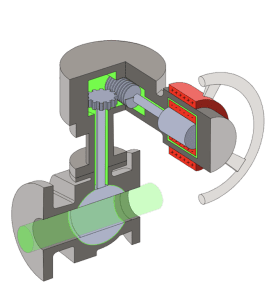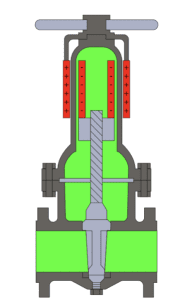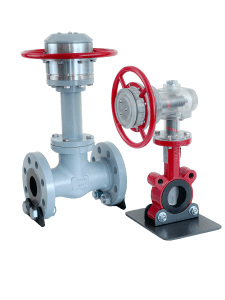This article explores the advancements in valve technology, particularly the potential of magnetic actuation, to achieve zero emissions and drive sustainability in the oil and gas industry.
By Bronson Pate, Vice President MagDrive Technologies, and Gobind Khiani, President GAPV Incorporated
Valve technology has evolved significantly since its early origins, driven by the need to regulate steam and high pressure in the 1700s. The establishment of the American Petroleum Institute (API) in 1919 and the International Organization for Standardization (ISO) in 1947 led to the development of key standards, such as ISO 15848-1, API 622, 624, and 641, which have played a crucial role in reducing the environmental impact of fugitive emissions. The United States Environmental Protection Agency (USEPA) recognized “Leakless Equipment” in the 1980s, although it was not widely accepted at the time due to the unreasonable emission reduction per control cost. The mid-2000s introduced Consent Decrees requiring Certified Low Leaking Technology (CLLT) for valves and packing in Volatile Organic Compound (VOC) Gas Vapor (GV) or Light Liquid (LL) service, limiting leaks to <100 ppm. The USEPA, currently under President Biden’s direction, is proposing changes to the Clean Air Act, 40 CFR 60, to revise new source performance standards for greenhouse gas and VOC emissions from the oil and gas industry.

These proposed Clean Air Act revisions aim to reduce methane and VOC emissions by no longer allowing the use of natural gas-driven controllers at new, reconstructed, and modified emission sources.
Additionally, according to the 2021 Inventory of U.S. Greenhouse Gas Emissions and Sinks (GHGI), pneumatic controllers in petroleum and natural gas systems are responsible for a significant portion of methane emissions in their respective industries. A report by Carbon Limits identified pneumatic controllers as the second-largest source of methane emissions in the oil and gas industry, behind component leaks. While valve standards help reduce fugitive emissions, which account for 90% of all emissions according to the USEPA, the goal of zero leakage has not yet been achieved.
Both natural gas-powered actuators and pneumatics, traditionally used in oil and gas facilities and pipelines, vent methane and greenhouse gases (GHGs) to the atmosphere, contributing to global warming. The USEPA documents categorize natural gas-driven pneumatic controllers into high-bleed, low-bleed, and intermittent types, with intermittent controllers responsible for 88% of all methane emissions. New regulations, such as OOOOb New Source Performance Standards and OOOOc Emission Guidelines, will restrict the installation of gas-emitting controllers. Several U.S. states and Canadian provinces have already implemented restrictions on emitting controllers, requiring the use of non-emitting or zero-emission alternatives.
Industry response to regulations and pressure
These proposed regulations, along with public and financial pressure brought about by the ESG requirements, are going to affect all segments of the oil and gas industry and, therefore, are under intense analysis by industrial and compliance organizations. As with most actuator applications, there are multiple reduction options depending on unit location, number of controllers, type of controllers already installed, operating media, customer philosophy, history with various products, and economics. The economic consideration can be broken down into several categories, such as initial material cost, total installed cost, total cost of ownership, etc.
Due to these pressures, the oil and gas industry is looking into the following options:
- Instrument air conversion: Use of compressed air system to operate pneumatics (if site is grid connected this is an economical option)
- Self-contained solar powered instrument air compressors for use with instrument air driven controllers
- Nitrogen: Conversion, like instrument air, by retrofitting existing pneumatics to use nitrogen.
- Electric actuation: This involves replacing a gas-powered pneumatic controller with an electric motor-driven controller (grid powered or solar-powered)
- Spring-Return electric operators (grid powered or solar powered)
- High-efficiency gear operators
The best approach depends on the specific needs and resources of each site. Implementing zero venting strategy can help minimize the environmental impact on these GHG and methane emissions ideally resulting in a sustainable industry.
The quest for zero-emissions
The USEPA’s proposed regulations focus on the “best system of emission reduction”, which generally requires the use of zero-bleed controllers, with few exceptions. Three common actuators – gas over oil, direct gas, and natural gas-driven low-pressure, will need modifications for new installations. Self-contained natural gas-driven controllers with recompression systems and those with vent recovery systems will still be allowed, but owners will be required to perform quarterly inspections and maintain records. Despite the USEPA allowing “no detectable emissions” (NDE) components and testing standards proving valves operate at less than 100 ppm on average, many components are still found leaking greater than 500 ppm over time. The USEPA’s statement during the public comments of NSPS VVa indicates that NDE components would be considered in violation if found leaking, discouraging their use. This raises the question: what if the industry could find a true NDE component or one that never exceeds the ambient air reading?
Producing zero-emission components is a reality that has been around for many years on pumps. Production of valve components has shown significant improvement against USEPA standards but have yet to reach a true zero-emission possibility. What if technology has finally caught up on valves? Magnetic valves are designed to both meet both NDE and zero-emission environments. To hit the global goal of “net zero” by 2050, these technological strides will be a strategic piece in achieving a viable “net zero.”
Embracing magnetics and change
 For the industry to keep pace with ever-changing regulations, it must be agile and willing to seek alternatives or advancement. The “old” way may seem to be working perfectly well, but it does not stay current with technological improvements and a better understanding of environmental impacts. When considering new technologies, questions arise about the capabilities of magnets in valve operation. Magnetics have great potential, with a half-inch diameter shaft capable of being sheared when magnetic actuation creates 900 to 1000 in-lbs in torque. This allows for the calculation of infinite shear, enabling the magnets to skip when maximum torque is achieved in either opening or closing. Magnets can also work in high and low temperatures, with some gaining up to 40% additional strength at cryogenic temperatures and others operating over 1000 degrees Fahrenheit, where leaks are often a significant problem.
For the industry to keep pace with ever-changing regulations, it must be agile and willing to seek alternatives or advancement. The “old” way may seem to be working perfectly well, but it does not stay current with technological improvements and a better understanding of environmental impacts. When considering new technologies, questions arise about the capabilities of magnets in valve operation. Magnetics have great potential, with a half-inch diameter shaft capable of being sheared when magnetic actuation creates 900 to 1000 in-lbs in torque. This allows for the calculation of infinite shear, enabling the magnets to skip when maximum torque is achieved in either opening or closing. Magnets can also work in high and low temperatures, with some gaining up to 40% additional strength at cryogenic temperatures and others operating over 1000 degrees Fahrenheit, where leaks are often a significant problem.
Since the valve doesn’t rely on a dynamic packing with magnets, testing has shown a magnetic valve actuating over 40,000 additional actuations even after completing an API 6FA fire test. With some new technology, changes must be made to the existing structures. As with most new technologies, changes must be made to existing structures. These footprint changes may be costly, and sometimes, the existing infrastructure can limit the redesign opportunities for new technology installation. With magnetics, valve infrastructure does not have to be redesigned; the magnetic components are installed over the valves already in place, and you no longer would have to worry about the safety hazard of the stem sticking out.
Zero fugitive emissions with magnetic actuation
So, with some of the most challenging questions answered, the only possible question is: How can you truly have zero fugitive emissions? When exploring a traditional valve, at least 90% of all leaks can be found from the packing to the stem area, as both areas are dynamic. Traditional valves may also leak at the bonnet gasket, but since it is a static seal, these types of leaks are less prevalent. Magnetic actuators can be integrated into most standard valves as a retrofit. With this retrofit, the only potential leaking interface would be the gasket used when attaching to the bonnet. 
All dynamic leaking interfaces have been eliminated, and the magnetic actuator is fully encapsulated with a solid wall. It does not have any external actuation, thus making a magnetically actuated valve more like a check valve. The USEPA agrees, as published in the “Inspection Manual: Federal Equipment Leak Regulations for the Chemical Manufacturing Industry,” dated December 1998, that states “Since a check valve has no stem or subsequent packing gland, it is not considered a potential source of fugitive emission and is not subject to the standards.” So, two directions could be made when placing a magnetic Zero-E valve into service.
The first could be to designate this component as NDE, which allows the end-user to only monitor the component once a year. Second, without having any external actuation, you could classify a magnetic zero-emission, gate, globe, plug, or ball valve categorically as check valves. This would remove all monitoring required for that component indefinitely.
Driving emission reduction
Driving emissions reduction towards zero-emission solutions will be a way of the future. Fugitive emissions have been listed as an “Enforcement Alert” related to refineries since 1999. Since 2000, refineries have been under agreed settlements called Consent Decrees (CDs). These CDs have helped decrease emissions from refineries, but each facility hits a plateau in emission reduction.
Zero-emission solutions can interrupt these trends and begin to deliver emission reduction again. For example, if only 5% of leaking valves at a facility are exchanged for a zero-emission solution, a decrease of 63% in fugitive emissions can be reduced. The same reduction can be found if you want a decline of CO2e for your Net-Zero 2050 goals.
This reduction is not an estimate. Factors were achieved using reported emission data from valves at both facilities. In addition to delivering substantial emission reduction, zero-emission solutions also eliminate the need to put a human into an operating facility for monitoring. Because, as discussed above, zero-emission solutions like magnetic actuation eliminate the leak path, monitoring requirements are either significantly reduced or nonexistent. Considering the evolution and advancements in the industry, processes have become more complex; we have dug deeper, operate at more extreme temperatures and pressures, and are processing more harmful and lethal materials at a higher rate than ever before. With that, we must parallel these advancements with advancements in compliance technology. Collectively, we also now understand the harsh impact of failure in these systems thanks to the advances in monitoring and general environmental impact studies. The solutions working fine 50 years ago may not be the best solution for today or tomorrow.
About this Technical Story
This Technical Story is an article from our Valve World Magazine, June 2024 issue. To read other featured stories and many more articles, subscribe to our print magazine. Available in both print and digital formats. DIGITAL MAGAZINE SUBSCRIPTIONS ARE NOW FREE.
“Every week we share a new Technical Story with our Valve World community. Join us and let’s share your Technical Story on Valve World online and in print.”

